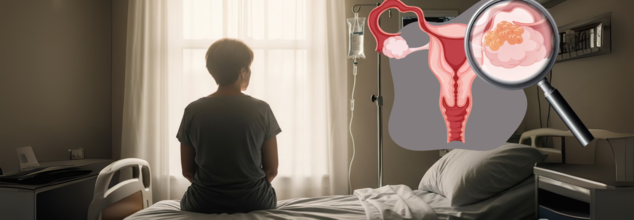- Health Conditions A-Z
- Health & Wellness
- Nutrition
- Fitness
- Health News
- Ayurveda
- Videos
- Medicine A-Z
- Parenting
- Web Stories
Cancer Clinical Trials Face Low Participation - Why Are More People Not Encouraged To Try?

(Credit-Canva)
Over the past several years, healthcare professionals and scientists have made great strides in the medical field. Not only have they found better ways to treat the patients, but they have also found treatment options for diseases and conditions that were long though incurable. For a long time, we believed cancer had no treatment, however through research, we now know how to deal with these.
This amazing progress is mostly thanks to new ways we've learned to prevent cancer, better tools to find it early, and more effective treatments. A huge part of developing these new ideas comes from clinical trials. These trials are carefully planned experiments that test if new treatments or ways to fight cancer actually work and are safe. Even though they're super important, not enough people are joining them.
Who Participates The Most In These Clinical Trials?
Even though clinical trials are so important for finding new cancer cures, only a small number of adult cancer patients – about 2% to 5% – actually take part in them. What's even more concerning is that certain groups, especially Black and Native Americans, are often left out.
A recent study published in the Patient Education and Counseling journal looked into this and found that very few cancer survivors – just 15% – had ever talked to their doctors about clinical trials. The study also showed that Hispanic-American and Asian-American patients often knew less about how these trials work. This tells us there's a big gap in how much people know and whether they're even offered the chance to participate.
How Many People Are Aware of Clinical Trials
Since cancer clinical trials are so important, the new study wanted to find out how much people really knew about them. They looked at information from 1,201 adult cancer survivors who answered a survey in 2021. The results showed that 78% of them felt they knew at least "a little" about clinical trials.
However, the surprising part was that only 178 of these survivors (or 15%) had actually talked about trials with their doctors. The study found that if someone did talk to their doctor about clinical trials, they were almost nine times more likely to feel knowledgeable about them. This highlights how important that conversation with a healthcare provider can be. Researchers found that,
- People with more advanced cancers were much more likely (over 3.6 times) to have discussed trials with their doctors compared to those with early-stage cancers.
- Patients with more education, better healthcare, and more financial stability generally knew more about clinical trials.
- Sadly, Hispanic and Asian cancer survivors, as well as those who didn't go to college, knew less about clinical trials.
Having many different kinds of people in trials is crucial. It means that cutting-edge treatments are available to everyone, no matter their race, education, or income. It also helps doctors be sure that new treatments work well for all different kinds of people.
Clinical Trials and Their Benefits
Clinical trials are organized studies that test new approaches to treat, prevent, detect, or manage a disease like cancer. Think of them as very specific research projects. For example, a trial might focus only on a new medicine for a certain type of stage 3 breast cancer.
Experts explain that joining a trial gives the patient an opportunity to try something new, which may end up being more useful to them. Even if someone is in the group that doesn't get the new drug, they still often get more careful medical attention than they might otherwise. This is because trials are so well-organized and carefully watched.
Because of successful clinical trials, more than 120 new cancer medicines were approved between 2003 and 2021. This shows just how vital these studies are for bringing new hope to patients.
If you're curious about clinical trials, experts suggest you talk to your doctor. Ask them if there are any trials happening at their hospital or a nearby one that might be right for you. If your doctor hasn’t asked, don’t be afraid to bring it up. Healthcare professionals are strong advocates for people standing up and speaking for their care.
'I Thought It Was Something I Ate', Woman Got Diagnosed With Stage 4 Ovarian Cancer After A Routine Ultrasound Revealed Terminal Illness

Credits: Health and me
A 57-year-old schoolteacher from Kolkata, Ruma Sen* had spent decades standing in front of classrooms, guiding young minds with poise and patience. But when her own body began to send quiet warnings—persistent bloating, fatigue that lingered, clothes fitting tighter than usual—she brushed it off. “I just assumed it was something I ate or part of aging,” she recalls. Yet, deep down, a quiet concern stirred. And then came the ultrasound that changed everything.
A mass on her left ovary. Fluid accumulating in her abdomen. The CT scan and biopsy confirmed what no one wants to hear: Stage IV high-grade serous ovarian cancer, with metastases to her intestines and abdominal lining.
“I felt like the floor had vanished beneath my feet,” Ruma says. “In that moment, the future I imagined just disappeared.”
“Ovarian cancer often whispers until it roars,” explained Dr. Debapriya Mondal, Ruma’s medical oncologist at Apollo Cancer Centre, Kolkata. “By the time it's diagnosed, it's usually advanced. But even Stage IV isn't without hope.”
This late-stage diagnosis is common with ovarian cancer, especially its most aggressive subtype—high-grade serous carcinoma. It lacks early symptoms that are easily distinguishable from benign issues like indigestion or menstrual irregularities. That’s why it’s dubbed the “silent killer.”
Round One: Chemotherapy as the First Line of Defense
Chemotherapy began within days of diagnosis. The plan was clear: shrink the tumors to make surgery safer and more effective. The process, however, was anything but clinical for Ruma.
“The first cycle made me violently nauseous. My hair fell out in clumps. I was too weak to stand some mornings,” she remembers. Despite the toll, the treatment was working. By the third cycle, imaging showed significant tumor shrinkage.
“Chemotherapy is brutal,” Dr. Mondal admits. “But when the scans show tumors shrinking, it’s our signal that we’re fighting back—and winning ground.”
Round Two: A Critical Turning Point Surgery
Ruma’s next hurdle was interval debulking surgery, a complex procedure to remove all visible tumors, followed by HIPEC (Hyperthermic Intraperitoneal Chemotherapy)—a method where heated chemotherapy is delivered directly into the abdominal cavity during surgery.
“It was the toughest part,” Ruma says. “I woke up in ICU with tubes everywhere. My abdomen felt like it was on fire.” Recovery was grueling. Ten days in the hospital marked by small but vital victories: sipping water, standing unaided, breathing without assistance.
“HIPEC is not for every patient,” Dr. Mondal says. “But in selected cases like Ruma’s, it increases the chances of a long remission or even a cure.”
Round Three: Genetic Testing and Personalized Medicine
As Ruma regained strength, her care team ordered homologous recombination deficiency (HRD) testing, a genomic analysis that helps determine how well a tumor repairs its DNA. The results revealed a germline BRCA1 mutation, a known genetic driver of ovarian cancer.
“This changed everything,” Dr. Mondal explains. “When tumors carry this mutation, we can use targeted maintenance therapy, such as PARP inhibitors, which drastically reduce the risk of recurrence.”
For Ruma, the discovery was both empowering and alarming. “I now had a new weapon against my cancer. But I also worried about what it meant for my daughters.”
She completed three more cycles of chemotherapy and transitioned to oral PARP inhibitors—medications designed to exploit her cancer’s genetic vulnerabilities. For the next two years, she remained under strict oncologic surveillance, with regular scans and bloodwork to track any signs of recurrence.
Ruma’s diagnosis didn’t just change her life—it changed her family’s trajectory.
Her two daughters, Megha** and Ananya**, underwent genetic counseling and testing. Megha, the elder at 35, tested positive for the same BRCA1 mutation. “It was a gut punch,” Megha says. “But I felt lucky to know.”
After consulting with specialists, she opted for risk-reducing salpingo-oophorectomy (RRSO)—a preventive surgery to remove her ovaries and fallopian tubes. “It meant early menopause. But it also meant I was taking control of my future,” Megha explains.
According to Dr. Mondal, this kind of cascade testing—where family members of patients with genetic mutations are screened—is vital. “We now have tools not just to treat cancer, but to prevent it. Megha’s decision may have significantly lowered her lifetime risk of ovarian and breast cancer.”
Today, Ruma is in clinical remission. She has resumed teaching, started leading yoga sessions for cancer survivors, and advocates for genetic testing and early detection. “I used to fear my body,” she admits. “Now I listen to it. I take care of it.”
She also speaks publicly about her cancer journey, helping dismantle the stigma and fear surrounding a disease that affects nearly 300,000 women worldwide each year, according to the World Health Organization.
“We are in a new era of precision oncology,” Dr. Mondal emphasizes. “We are no longer limited to one-size-fits-all treatments. Every tumor has a story written in its DNA—and we’re learning how to read it.”
Why It Is Important To Listen to Your Body?
Ruma’s story is more than a personal victory. It’s a real-world example of how modern oncology is evolving—from late diagnosis to targeted intervention, from suffering in silence to survivorship with purpose. Here’s what it tells us:
- Listen to your body, even when the symptoms seem minor.
- Early diagnosis remains rare, but genetic insights can improve long-term outcomes.
- Precision medicine—like HRD testing and PARP inhibitors—is rewriting how we approach advanced cancer.
- Genetic counseling empowers entire families, not just patients.
- And most importantly, survival is possible, even in Stage IV.
“I don’t know what the future holds,” Ruma says. “But I know I’ve done everything in my power to live it fully.”
Disclaimer: This article is based on a real-life medical journey. To protect the privacy of the individual and her family, names and identifying details have been changed. Medical information shared is for educational and awareness purposes only and should not be considered a substitute for professional medical advice, diagnosis, or treatment.
New Weekly Injection Could Revolutionize Parkinson’s Treatment

Credits: Canva
A team of researchers at the University of South Australia (UniSA) has developed a weekly injectable drug that could significantly improve the lives of people living with Parkinson’s disease. The new treatment, which offers a steady release of key medications over seven days, may eliminate the need for multiple daily pills — a major breakthrough for both patients and caregivers.
Consistent Dosing, Less Burden
The injectable has been designed to maintain consistent levels of levodopa and carbidopa — two medications that form the cornerstone of Parkinson’s treatment. These drugs typically need to be taken multiple times a day to manage symptoms effectively. However, this frequent dosing can be challenging for patients, especially older adults or those who have difficulty swallowing pills.
“This new formulation is about simplifying care,” said Professor Sanjay Garg, lead researcher from UniSA’s Center for Pharmaceutical Innovation. “Our goal was to create a treatment that ensures consistent drug levels in the body, reduces dosing frequency, and makes life easier for patients.”
According to the study, published in the journal Drug Delivery and Translational Research, the weekly injection uses biodegradable polymers to deliver the medications slowly and steadily into the body. The formulation can be injected under the skin or into the muscle using a fine needle — avoiding the need for surgery or implants.
Promising Lab Results
In lab tests, the injection successfully released over 90% of levodopa and 81% of carbidopa within a seven-day period. Importantly, the biodegradable implant degraded by more than 80% during that time and showed no significant toxicity in safety evaluations.
“We're not just improving how the drug is delivered — we're improving patients’ lives,” Professor Garg said. “This could be a game-changer for people with Parkinson’s who struggle with the current complex medication schedules.”
The researchers also noted that this delivery platform could be adapted to treat other chronic diseases such as diabetes and cancer. Plans for clinical trials and commercial development are already underway.
Understanding Parkinson’s Disease
Parkinson’s disease is a progressive neurological disorder that affects movement and coordination. It occurs when nerve cells in the brain that produce dopamine — a chemical messenger that controls movement — begin to die.
Common symptoms include:
- Tremors or shaking
- Muscle stiffness
- Slowed movement
- Balance and coordination issues
Difficulty walking or talking in advanced stages
There is currently no cure for Parkinson’s, but medications like levodopa help manage the symptoms by replenishing dopamine levels in the brain. However, the effects of these medications can wear off quickly, requiring frequent dosing throughout the day.
According to the World Health Organization, more than 8.5 million people worldwide are living with Parkinson’s disease — a number that has doubled in the past 25 years. The disease also carries a significant economic burden due to ongoing medical care, medications, and caregiving needs.
A 2020 study published in The Lancet Neurology noted that the global cost of Parkinson’s could reach over $79 billion annually by 2030 if no major advancements in treatment are made.
Menopause Age Plays A Significant Role In Our Future Heart Health - Can You Delay The Age?

(Credit-Canva)
Menopause brings big changes to a woman's body, however, many do not know how these changes affect their health. A Jan study published in the Circulation Research showed that when a woman goes through menopause could tell us a lot about her future heart health. A study published recently found that women who stopped having periods later in life generally had healthier blood vessels. They were also much less likely to suffer heart attacks and strokes after menopause, compared to those who went through it earlier.
Menopause And Heart Health
The researchers also noted that these women who had later menopause had better fat levels in their blood and fewer signs of "oxidative stress". This might help explain why their hearts seemed healthier.
Most women enter menopause between ages 45 and 55, with the average in the U.S. being 52. However, about 10% of women experience "late-onset" menopause, meaning it starts after age 55.
Late Menopause and Your Heart Disease Risk
For this study, researchers looked at 21 women who were still having periods and 71 women who had already gone through menopause. The postmenopausal group was then split based on whether their menopause started at a normal age or later.
To check their heart and blood vessel health, the researchers measured how well a main artery in the arm could widen. They also looked at the health of the mitochondria inside blood vessel cells, and checked levels of hormones, fats, and other substances in the blood.
As expected, all women who had gone through menopause had less healthy blood vessels compared to those still having periods. This is normal as estrogen levels drop and blood vessels tend to stiffen with age. Also, as we get older, these "power plants" in our cells can produce more harmful molecules called free radicals, leading to something called oxidative stress, which can cause diseases like heart disease.
However, the surprising finding was that women in the late-onset menopause group seemed to be somewhat protected from this age-related decline in blood vessel health.
Their blood vessel function was only 24% worse than the premenopausal group, while for those with normal-onset menopause, it was 51% worse. This better blood vessel function lasted for at least five years after menopause for the late-onset group. Women in the late-onset group also had better functioning "power plants" (meaning fewer harmful free radicals and less oxidative stress) and healthier fat levels in their blood.
Why Menopause Impacts Heart Health
Even though women with later menopause had relatively better heart health in the study, it's important to remember that all women face a higher risk of heart disease once they go through menopause.
Studies show that this is largely due to estrogen. According to the Oxidative medicine and cellular longevity journal, estrogen is known to protect against heart disease. Once a woman's estrogen levels drop during menopause, she starts to lose that protective effect. As a result, many women will see their blood pressure and cholesterol levels go up, even if their diet and activity levels don't change.
So, it makes sense that women who go through menopause later have better heart health. The longer your body produces estrogen, the more protection your heart gets. Blood vessels work better before menopause, meaning they are more resistant to damage and heart attacks the longer you stay out of menopause.
Protecting Your Heart During and After Menopause
While you usually can't control when you start menopause, you can still take steps to protect and maintain your heart health during and after this transition. This includes following the usual advice for a healthy lifestyle:
- Starting a healthy diet with more fruits and vegetables, and less meat and cheese.
- Monitor your cholesterol levels.
- Staying active is crucial, aim for at least 30 minutes of exercise most days of the week, including both cardio and strength training
- Getting enough sleep is also vital for heart health; however, this can be tough during menopause due to issues like insomnia and night sweats.
© 2024 Bennett, Coleman & Company Limited

